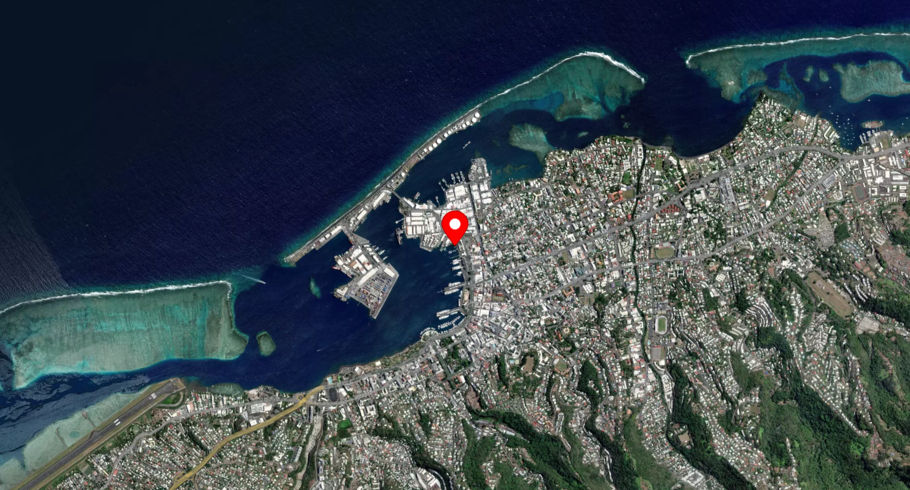Port of Papeete, Tahiti – Key Facts, History, Facilities & Future Plans
- CNXtrans

- Jul 20
- 5 min read
The Port of Papeete (French: Port de Papeete) is the principal maritime gateway to Tahiti, the largest island in French Polynesia, and serves as the administrative, commercial, and logistical hub for the entire overseas collectivity of France in the South Pacific. Strategically situated on the northwest coast of Tahiti in the capital city of Papeete, the port plays a vital role in the economic and cultural life of the region, serving both international and inter-island maritime traffic.
Geographic and Strategic Significance
Located in the Society Islands, the Port of Papeete is positioned within a naturally sheltered harbor, protected by coral reefs, which makes it a secure anchorage for vessels of various sizes. Its geographic coordinates are approximately 17.5357° S latitude and 149.5696° W longitude. Papeete lies roughly midway between the western coastlines of the Americas and Australia, making it an important stopover point for trans-Pacific shipping and cruising routes.
The port is a key logistical node in the South Pacific, facilitating maritime connections between French Polynesia and global trade partners, particularly in Asia, North America, and Oceania. Its centrality within French Polynesia also makes it indispensable for ferrying goods and passengers to outlying islands.
Historical Background
The Port of Papeete has its origins in the early 19th century, when European exploration and missionary activities first intensified in the region. By the mid-1800s, following the establishment of French control over Tahiti, the port began developing as a colonial outpost. Over the decades, as maritime commerce and tourism grew, the harbor expanded to accommodate larger ships and more diverse types of cargo.
In the post-World War II era, the port underwent significant modernization to meet the demands of increased trade and the burgeoning tourism industry. The advent of containerization and the rise of Tahiti as a luxury cruise destination further catalyzed its transformation into a modern, multi-functional port facility.
Infrastructure and Facilities
The Port of Papeete features a variety of facilities designed to handle a broad spectrum of maritime activities:
Cargo Terminal
Container Handling: The port has a dedicated container terminal equipped with gantry cranes, reach stackers, and other cargo handling equipment.
Storage Facilities: Warehousing, cold storage, and container depots are available to support the storage of both import and export goods.
Customs and Inspection Services: On-site customs and quarantine facilities expedite the clearance of international cargo.
Passenger Terminal
Cruise Ships: A modern terminal accommodates international cruise liners. Papeete is a popular port of call for major cruise lines operating in the Pacific.
Ferry Services: Inter-island ferries operate frequently, connecting Tahiti to neighboring islands such as Moorea, Huahine, Raiatea, and Bora Bora.
Fishing and Yachting
Fishing Port: A separate area of the port caters to the commercial fishing industry, which plays an essential role in the local economy.
Marina Facilities: The port includes marinas for yachts and pleasure craft, many of which are long-distance cruisers stopping in Papeete while crossing the Pacific.
Operations and Management
The port is managed by the Port Autonome de Papeete (PAP), an autonomous public entity under the jurisdiction of the Government of French Polynesia. The PAP oversees all port operations, infrastructure development, safety regulations, and environmental compliance.
The port authority is responsible for:
Allocating berths and anchorage zones
Managing freight logistics
Ensuring maritime safety and security
Conducting dredging and maintenance
Developing port infrastructure in line with economic growth
The Port of Papeete operates 24 hours a day, seven days a week, with well-coordinated shifts of dock workers, customs officials, and port management staff.
Economic Role
As the principal point of entry for imported goods and a critical export node, the Port of Papeete is central to the economy of French Polynesia. Key imports include:
Machinery and vehicles
Processed foods
Construction materials
Petroleum products
Primary exports shipped via the port include:
Black pearls (a major economic asset for French Polynesia)
Tropical fish
Copra and noni juice
Agricultural and artisanal products
The port also significantly contributes to the tourism sector, one of the territory’s primary sources of income. Cruise tourism alone brings thousands of visitors annually, many of whom start or end their journey at Papeete.
Environmental and Sustainability Initiatives
Recognizing the fragility of the South Pacific environment, the Port of Papeete has implemented a series of sustainability initiatives aimed at minimizing ecological impact:
Waste Management: Ships are required to dispose of waste in designated facilities; marine pollution is strictly prohibited.
Green Energy: The port authority is exploring renewable energy sources and energy-efficient lighting systems.
Eco-Friendly Infrastructure: Future development plans include eco-conscious materials and stormwater management systems.
Cruise Tourism and Passenger Services
Cruise traffic has grown steadily over the past two decades, positioning Papeete as one of the leading cruise ports in the South Pacific. It serves as a homeport and a port of call for luxury liners operated by companies like Princess Cruises, Paul Gauguin Cruises, Windstar, and Regent Seven Seas.
Cruise passengers enjoy access to:
Downtown Papeete, which is adjacent to the port
Local markets and cultural attractions
Shore excursions to waterfalls, black sand beaches, and historic sites
The port’s location makes it ideal for beginning or ending regional cruise itineraries, with direct access to Tahiti Faa’a International Airport.
Connectivity and Logistics
In addition to sea transport, the port is well connected to Tahiti’s road network and lies just 5 kilometers from Faa'a International Airport, the main air gateway to French Polynesia. This proximity enhances multimodal logistics, facilitating the transfer of airfreight and passengers to maritime carriers and vice versa.
Inter-island shipping services are also coordinated through the Port of Papeete, ensuring timely deliveries of food, fuel, and essential supplies to remote island communities across the archipelago.
Future Development Plans
To accommodate increasing maritime traffic and ensure long-term competitiveness, the Port Autonome de Papeete has laid out several strategic initiatives:
Port Expansion
Deepening the harbor to accommodate larger vessels
Expanding container terminal capacity
Upgrading cruise terminal facilities
Smart Port Technologies
Implementing digital tracking systems for cargo
Introducing automated scheduling and logistics platforms
Sustainability Goals
Increasing the port’s energy independence
Supporting marine biodiversity in adjacent waters
Challenges and Opportunities
Despite its strengths, the Port of Papeete faces several challenges:
Geographic isolation, which increases shipping costs
Limited land for expansion due to urban constraints
Vulnerability to climate change and rising sea levels
However, these challenges are counterbalanced by significant opportunities:
Rising cruise tourism
Regional trade partnerships
Investment in green port infrastructure
In Popular Culture and Local Life
The Port of Papeete has long been a fixture in the cultural landscape of Tahiti. It appears in travel documentaries, sailing logs, and maritime literature as a romantic and exotic destination. For locals, the port is not just a place of commerce but also a gathering point, especially during ship arrivals and cultural festivals.
The Port of Papeete stands as the maritime heart of French Polynesia, offering a unique blend of functionality, beauty, and cultural significance. As both a critical economic engine and a gateway to the islands, the port exemplifies the integration of modern infrastructure with Pacific island heritage. With ongoing investments in sustainability, digital innovation, and capacity expansion, the Port of Papeete is well positioned to maintain its strategic importance in the South Pacific well into the future.
Need a China-based Shipping Agent to help you consolidate and ship internationally from China?





Comments